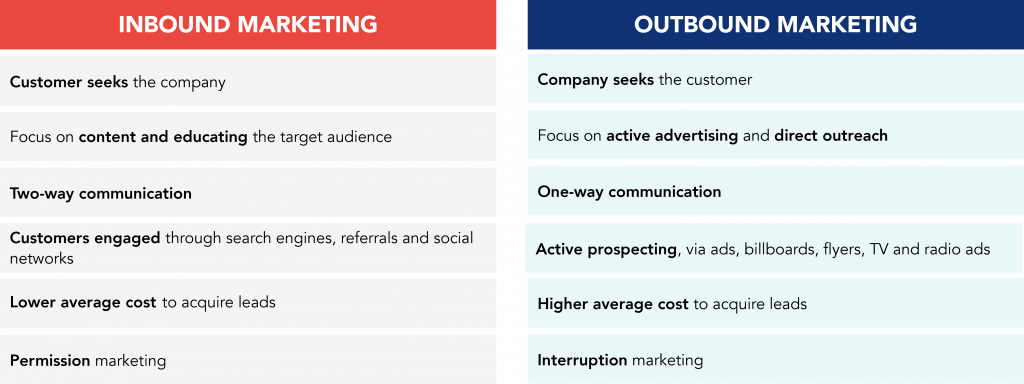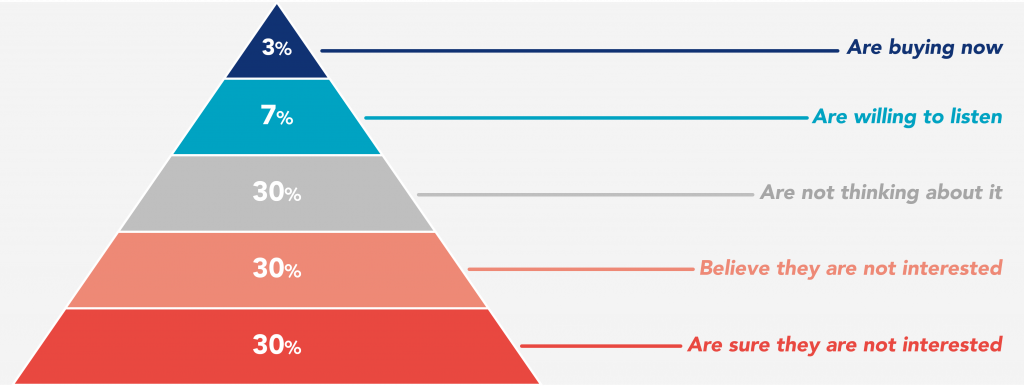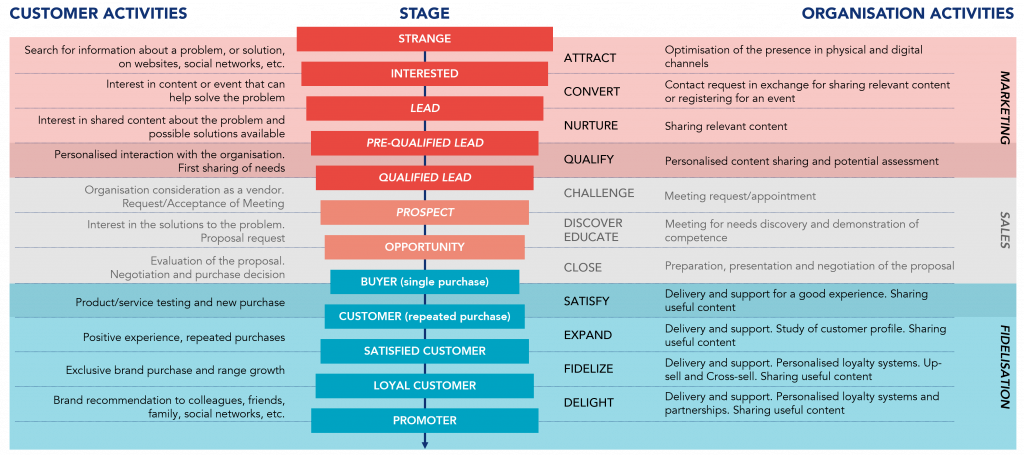Lead generation is a relevant process for any business. It is the method used to capture the attention of potential customers and convert them into buyers, thus increasing sales.
A lead is any person who has shown interest in a company’s products or services and has provided contact information. There are two possible strategies for lead acquisition: passively, with Inbound Marketing, and actively, with Outbound Marketing. When worked in an integrated way, these two strategies can drive companies to the best results with the lowest possible cost.
Inbound Marketing includes all strategies to attract and convert customers by producing relevant content. In this approach, the company does not go after customers, interrupting them, but instead explores channels such as search engines, blogs, and social networks to be discovered. The company produces valuable content to educate potential customers, turning the company into a reference or authority in its industry and influencing the buying decision. In Outbound Marketing or interruption marketing, the company goes after customers using approaches such as pop-ups, ads in search engines or social networks, and TV or radio advertising campaigns. In this strategy, the company has an active prospection process to meet potential customers.

Chet Holmes’ pyramid represents how the market behaves, with 30% of the target audience being sure they are not interested in the company’s product or service and only 10% in buying or learning more. One of the main insights that Chet Holmes’ pyramid brings is the importance of building a strategy tailored to each level. Content marketing and inbound marketing can play a relevant role for the levels that are not yet willing to buy.

What are the benefits of having a good lead generation strategy?
There are several benefits to having a good lead generation strategy, including:
- Increase brand visibility and position the company as a reference and authority in the sector of activity;
- Educate the market about the area in which the company operates and influence the buying process;
- Better understand the interests of the target audience and develop a better and more segmented value proposition;
- Get in touch with more potential customers, keeping the funnel always full of opportunities;
- Increase sales through more and more qualified leads;
- Reduce the cost of customer acquisition and increase the ROI of marketing activities.
Overall, a good lead generation strategy can help drive business growth in an efficient and sustained way.
Customer Lifecycle
The Customer lifecycle involves the customer’s entire experience with the company and describes this whole relationship. It represents all the stages a customer goes through, from “Stranger” to “Promoting Customer” of the brand.
A clear understanding of the stages a customer goes through until they buy helps the company define what activities they should perform to move the potential customer forward. The focus of this article will be the first stages of this cycle: attraction and conversion into a lead.

Attraction of Potential Customers
The attraction of potential customers is the stage that focuses on the beginning of the customer life cycle funnel. At this stage, the potential customer may not know if they want to buy something.
However, they understand that they have a problem that needs to be solved, and they perform research to try to get more information. You could say that this is the learning stage, as the potential customer will find out more about the solutions to their problem.
Different inbound marketing strategies can be used to attract potential customers. One of the most important is content marketing applied to the website, blog, and social networks. The more complete the content is, the more likely it is to attract a new potential customer and for the content to be shared. The content should focus on educating, not selling products or services at this stage.
If the target audience does not have a high digital presence, the communication channels will need to be adapted.
Site
Nowadays, the existence of an institutional website is vital for any business. First, it increases the credibility of the business. When people research a company, they need to be sure that the company is serious and reliable.
Second, because the site is another channel where people can find the company, if it is well developed in terms of SEO (Search Engine Optimization), it can rank in the top positions in search engines like Google.
Third, it is also essential that the Marketing actions direct potential customers to a place where they can clarify all their doubts and buy the products or services the company sells.
Blog
A blog is often called “the home” of content marketing. It allows businesses to share valuable content with their target audience without the interference and distractions other channels like Social networks can have.
A well-executed content marketing strategy for blogs can help companies to:
- Position themselves as thought leaders in their sector by sharing quality content and relevant information;
- Build a relationship with their potential customers, even before they are ready to buy;
- Increase brand visibility through SEO optimization, meaning potential customers can find the company when searching for sector-related information.
In short, a blog can be a powerful tool for attracting leads and building relationships with potential customers. It is important to focus on creating quality and relevant content to keep visitors interested.
Social network
Social networks enable the interaction of potential customers with brands and have primary goals to communicate, influence, and encourage dialogue.
Nowadays, it is essential to have a company page on the main social networks where the target audience is present, either to promote actions, share content, or for people to get to know, for example, the development and production process of the company’s products.
Consumers like to identify with the principles and values of the brands they buy from. And social networks are an excellent channel for sharing content to create that connection.
An effective social networks strategy is also of significant importance in generating traffic to the site, and, at the same time, it is a channel for brand communication and promotion.
Implementing a social networks strategy should start by defining goals and milestones and conducting benchmarking. After this first step, it is necessary to select the most appropriate social networks for the company and its target audience, create a profile, and define a plan and an editorial calendar. Once the activities have started, monitoring the indicators and continuously improving is necessary.
Some examples of social networks that companies can use:
- LinkedIn – It is the world’s largest professional network, so it is the best platform to learn about prospects and create a connection with them. It is one of the most used social networks by B2B (Business to Business) companies. LinkedIn can be used to explore the institutional and business side of the brand and be a way for the company to position itself as an authority. Through LinkedIn, the company can contact professionals from all areas for active prospecting and hiring or partnership development.
- Facebook – It offers different publication formats, such as images, lives, recorded videos, creation of events, and others. It also allows sending private messages and publicly sharing the customer’s company evaluation. Facebook is mainly used by B2C (Business to Consumer) companies, but there are also B2B companies using it.
- Twitter – It has the advantage of presenting content and informing concisely and objectively. The focus is on brief posts, which are updated quickly, maintaining continuous communication. It establishes a relationship with potential customers on subjects directed to daily activities. It becomes more effective with hashtags, which can integrate the trending topics (ranking the most commented, liked, and shared posts).
- Instagram – This platform stands out for using images and short videos essential for presenting a product or service. The image posted, combined with hashtags associated with the product, can ensure the business’s visibility.
- Youtube – It enables dynamic content delivery in video format in a specific company channel. It makes it possible to work with the publication of live broadcasts and create paid dissemination campaigns with ads about the brand.
Most social networks allow access to reports to track the number of visitors, views, interactions, and other indicators that will monitor performance and improve continuously.
All these strategies, or others not described here, should be worked as a whole, allocating resources to those that bring the best results for each type of business.
Leads Generation
In commercial relationships, lead generators or magnets are the means used to ask for contact information without being intrusive: “Please provide your email address so we can forward this relevant content to you.” Lead generators ensure that when someone finds the company interesting, they get to keep your contact information.
Customers are willing to provide their contact information when you succeed in sparking customers’ curiosity and positioning the company as a guide. At that point, one is officially in a committed relationship. It’s not yet time for a financial commitment, but the prospect has entered into a healthy business transaction with the company. Anyone willing to provide an email address is interested in the product or service.
A magnet is a free asset or content offered to potential customers to build authority and trust but requires the person to provide the contact to access it. A lead generator can be anything we can give to the potential customer that helps them solve a problem: an article, webinar, ebook, sample, participation in an event, etc.
Lead generators should:
- Generate interest: To do this, make sure you use a title that makes people want to know more. No one wants to download a pdf with the title “Case study,” but they want to download one with the title “See how company X doubled its revenue.”
- Position the company as a guide for customers and build trust: Share empathy and authority with the prospect. Show how the company is the right guide to help the customer solve their problem;
- Claim territory: Differentiate from the competition by sharing unique knowledge on a subject;
- Show how the customer’s life can be improved: Provide insight into the successful outcome the customer can achieve and challenge the prospect to move forward;
- Qualify the target audience: Segment the audience with which you want to speak. If the goal is to talk to multiple segments, create different lead generators to reach them;
- Create reciprocity: When value is given without associated costs, customers feel indebted to the company, even if unaware of it.
Magnets do not have to be complex. Each company is an expert in its own business and knows much more about the products they represent than potential customers do. They can position themselves as a guide by sharing some of that knowledge.
You can create several lead generators: articles, interviews with an industry expert, a checklist, a spreadsheet, an event, a sample, a webinar, an ebook, etc.
After the magnet has been developed, it needs to be promoted. One should consider promoting the lead generators in several ways: website and blog, social networks, and paid advertising (ads).
Create separate landing pages (LP) that focus solely on each lead generator is a great solution. This way, specific publications can be linked to particular pages.
A landing page is a page that has all the elements aimed at converting the visitor into a lead. LP usually have high conversion rates. The text should be direct, easy to understand, and enjoyable. The main elements of an LP for a lead generator are: title and subtitle, image, description of the offer, and form.

LPs do not need to look exactly like the website’s home page, but they must comply with the brand messaging principles, or the company risks confusing customers.
Several possible strategies for providing access to the lead generator LP include the website or blog, social networks, ads, co-marketing, etc.
Site and Blog
Once the lead generator has been created, the first thing to do is to promote it on the website.
Use the existing traffic on the website to promote the landing page on the most popular pages to generate leads and optimize conversion.
Pop-up ads can be used on the website as well. Pop-up ads can be “annoying”, but they usually work if used in moderation. Some tips for pop-up ads: give the visitor time to browse, use “intent to exit” pop-up, know the rules of the search engines so you do not get penalized, and do not let the ad close with an x.
Social networks
Take advantage of social networks, where the company is present, to publicize the landing page and generate leads.
Regardless of which social network, LinkedIn, Facebook, Twitter, Instagram, or others, there are people who may be interested in the company’s offer.
The advantage of using the company’s social networks is that the followers have already shown some interest in the respective area of activity.
Paid Advertising
Investments in paid advertising (Google Ads, LinkedIn Ads, YouTube Ads, …) are to be made gradually. It is recommended to start with a small amount to make short-term analyses. And after the analyses, check if there is potential to increase the investment.
It is necessary to track the ROI of the different campaigns and ensure that the resources are well invested.
In this type of campaign, monitoring the indicators daily and defining quick countermeasures when necessary is essential. A/B testing should also not be forgotten to understand which ads work best for the defined target audience.
Co-Marketing
Co-marketing is when two companies come together to create or promote content or product to a common target audience. This is another way to disseminate landing pages with the lead generator.
In this approach, the outreach of the message is much greater than if it were disseminated only by one company, and it allows for privileged access to a new audience that one would not usually have.
Just because the company joins forces with other companies producing content, it places itself as part of a small group of “gurus” to whom the market can turn for relevant information.
The Importance of Lead Generation for the Business
A good strategy for working early in the customer lifecycle is critical for any business. Only with a good approach is it possible to attract potential customers to the company and move them forward in the buying cycle to the first stage of the relationship.
For these first steps to be successful, it is necessary to use efficient traffic generation tactics on the website and Social networks to attract interested parties. Next, one must develop relevant content to convert interested parties into leads. A lead is someone who has given the contact information, such as name and email, usually to get access to a piece of content.
Once leads have been gathered, the process needs to be followed up to move potential customers forward in the buying process. The next step will be to nurture the leads to convert them into customers. Succinctly, it can be said that lead generation has the following benefits: increase brand visibility, educate the market, obtain the contact of potential customers, increase sales, and reduce the cost of customer acquisition.

See more on Sales & Marketing
Find out more about improving this business area
